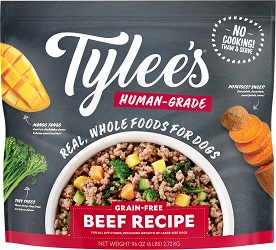The Rundown
Best Overall for Golden Retrievers: Wellness Core Large Breed Dog Food
“Wellness Core Large Breed Dog Food has a perfectly sufficient fat count for average, moderately active Golden Retriever while also maintaining a high protein content. Vitamins are added to keep the coat and skin of your pup healthy, and joint-strengthening supplements to keep them strong and agile.”
Best Food For Active Golden Retrievers: Merrick Backcountry Grain-Free Dog Food
“Merrick Backcountry Grain-Free Dog Food has great protein and fat count for your Golden Retriever. This kibble is made to sustain the active lifestyle of your pooch.”
Best For Seniors: Victor Senior Healthy Weight Recipe
“Victor Senior Healthy Weight Recipe provides super protein and fat levels for senior, less active Golden Retrievers. It also contains DHA to maintain healthy and bright brain and L-carnitine to regulate the energy level and help with digestion.”
The Golden Retriever consistently makes it into the top three most popular dogs, and for good reason. These beauties are smart, friendly, loyal, and make the perfect companion.
Golden Retrievers are also highly energetic and love a good romp, chase, or swim … As well as to eat.
If left to their own devices, they can become a bit roly-poly. If you are the parent of one of these lovely dogs, exercise and a diet featuring one of the best dog food will do wonders for their health.
The Golden Retriever dog foods on this list have been carefully assessed to make sure they’re amongst the best. It’s simply up to you to decide which would work for you and your fluff.




Table of Contents
- The Rundown
- Best Dog Food For Golden Retrievers
- Wellness Core Grain-Free Large Breed Dog Food
- Merrick Backcountry Grain-Free Dry Dog Food
- Victor Senior Healthy Weight Dry Dog Food
- American Journey Grain-Free Dog Food
- Pupford Freeze-Dried Training Treats
- Orijen Puppy Large
- Diamond Naturals Skin & Coat Recipe
- Acana Singles Range
- Tylee’s Human-Grade Frozen Dog Food
- Wellness Core Grain-Free Large Breed Dog Food
- Things to Consider When Buying Dog Foods
Best Dog Food For Golden Retrievers
Here are the best dog food for Golden Retriever!
- Best Overall for Golden Retrievers: Wellness Core Large Breed Dog Food
- Best Food For Active Golden Retrievers: Merrick Backcountry Grain-Free Dog Food
- Best Dog Food for Senior Golden Retrievers: Victor Senior Healthy Weight Recipe
- Best for Hypothyroidism: American Journey Grain-Free Dog Food
- Best Training Treat for Golden Retrievers: Pupford Freeze-Dried Training Treats
- Best For Puppies: Orijen Puppy Large
- Best Value For Money: Diamond Naturals Skin & Coat Recipe
- Best Dog Food For Golden Retrievers with Limited Ingredient: Acana Singles Range
- Best Fresh Dog Food Option: Tylee’s Human-Grade Frozen Dog Food
Wellness Core Grain-Free Large Breed Dog Food
Best Overall Dog Food for Golden Retrievers

Check Price on Amazon
Check Price on Chewy.com
PROS
- Great fat count for Golden Retrievers
- High in protein from quality sources
- Good glucosamine and chondroitin levels for support to joints
- Contains added vitamin E and A (beta-carotene)
CONS
- Doesn’t contain DHA, although the fatty acid levels are good
- Pricey
For the average, moderately active Golden Retriever, the Wellness Core Large Breed Dog Food will provide a perfectly adequate fat count while still keeping a high protein content. There are added vitamins which will keep your pooch’s coat and skin healthy, and joint-strengthening supplements to keep them strong and agile.
click to see more
Merrick Backcountry Grain-Free Dry Dog Food
Best Food For Active Golden Retrievers

Check Price on Amazon
Check Price on Chewy.com
PROS
- Great protein level for active Golden Retrievers
- Higher fat count but still perfect for the Golden Retriever
- Fairly moderate calorie count despite the higher protein and fat
- High levels of joint-strengthening supplements
CONS
- A pricey option
- Doesn’t contain DHA
The fat count on the Merrick Backcountry Grain-Free Dry Dog Food is on the higher side but that’s what makes it perfect for Golden Retrievers who are active and get plenty of exercise in their day.
The fat count will provide your Golden Retriever a nice dollop of easily accessible energy for their daily activity, while the high protein count and added glucosamine will make sure their muscles and joints can keep up.
click to see more
Victor Senior Healthy Weight Dry Dog Food
Best For Golden Retriever Seniors

Check Price on Amazon
Check Price on Chewy.com
PROS
- Great protein and fat levels for seniors who may be less active
- Glucosamine and chondroitin to keep joints strong as they age
- Contains DHA, which will keep your senior’s brain healthy and bright
- Contains L-carnitine, which helps digestion and energy level regulation
CONS
- Doesn’t contain real meat (although meat meal is still a quality ingredient)
As your Golden Retriever gets older and starts slowing down a bit, they’ll need a dog food that has a lower fat level but contains enough supplements to keep them strong. The Victor Senior Healthy Weight Dry Dog Food provides all they’ll need to live their senior years being happy, healthy, and satisfied.
click to see more
American Journey Grain-Free Dog Food
Best for Hypothyroidism

PROS
- Contains kelp, which is a great nutrient for hypothyroidism
- Great quality ingredient list & is quite affordable
- Glucosamine and chondroitin levels are great
- High protein level and moderate fat count, perfect for Golden Retrievers
CONS
- High calorie count could contribute to weight gain if not careful
Hypothyroidism is one of the common conditions found in Golden Retrievers. The dog food you feed your Golden Retriever can make a difference, both in the development of the disease and in managing symptoms.
The American Journey Grain-Free Dog Food is a great choice for pups who suffer from hypothyroidism, and will help your pup live their healthiest life possible. It’s packed with premium, antioxidant-rich ingredients, contains kelp to stimulate the thyroid, and avoids beef, which can be a problem ingredient for pups with this condition.
click to see more
Pupford Freeze-Dried Training Treats
Best Training Treat
PROS
- Up to 600 treats per bag makes this fairly affordable
- All-natural, pure ingredients
- Super low in calories, which is great for pups who gain weight easily
- Low calorie count also means you can feed your pooch many in a single training session without worrying
CONS
- They may be too small for your Golden Retriever – you will have to figure this out as you go
Golden Retrievers are highly intelligent and easy to train, and it’s essential to have a great quality training treat. The Pupford Freeze-Dried Training Treats fits the bill as it’s low in calories and packed with only natural stuff, as well as being very limited ingredient.
click to see more
Orijen Puppy Large
Best For Golden Retriever Puppies
PROS
- Good protein and fat counts for growing puppies
- High-quality ingredient list
- Great calcium/phosphorus ratio and added glucosamine & chondroitin
- Contains DHA and EPA to help puppy eyes develop
CONS
- A little expensive
Puppies need slightly higher nutrient counts than adults, as well as some specific supplements to help them grow the way they should.
You’ll find all a developing puppy needs in the Orijen Puppy Large – puppy-perfect protein and fat counts, a great calcium/phosphorus ratio for optimal growth, brain and eye development supplements, and joint-fortifying fatty acids.
click to see more
Diamond Naturals Skin & Coat Recipe
Best Value For Money

Check Price on Amazon
Check Price on Chewy.com
PROS
- Avoids chicken and beef, which is great for both food allergies and hypothyroidism
- The most affordable option on the market
- High Omega levels to keep your pup’s skin and coat happy
- Contains superfood ingredients for an extra antioxidant boost
CONS
- “Fish meal” is a little vague
- Doesn’t contain glucosamine, so you will need to supplement
The Diamond Naturals Skin & Coat Recipe is the highest quality “cheap” dog food you’ll find on the market, and it’s on-par with the top-level, most pricey ones out there.
It contains the same premium quality, whole food ingredients, as well as extra supplements to protect against hypothyroidism and keep your Golden Retriever’s skin and coat healthy.
The only thing you’ll need to do is buy a separate glucosamine supplement, but for this price, you should be able to do that comfortably.
click to see more
Acana Singles Range
Best Limited Ingredient
PROS
- Various flavours available, so there’s something for every dog
- Limited ingredient helps reduce chances of allergies and intolerances
- Contains DHA and EPA & a good level of glucosamine
- Super calcium/phosphorus ratio
CONS
- Fat count may be a little high for less active dogs
Although Golden Retrievers are not usually prone to sensitive stomachs, all dogs are different and it may be that yours is a little more sensitive than average.
A limited ingredient dog food is super for avoiding ingredients that may cause digestive upset, and when it comes to choice and quality, you can’t beat Acana Singles.
They pack a lot of nutritional punch for just a few well-chosen ingredients, as well as having an unrivaled flavour variety to keep your pup from getting bored with their food.
click to see more
Tylee’s Human-Grade Frozen Dog Food
Best Fresh Dog Food Option
PROS
- Human-grade, which means this is super healthy
- Contains muscle and organ meat for plenty of amino acids
- Fruits and vegetables add vitamins, minerals, and antioxidants
- Low calorie, so your pup will get a good meal for fewer calories
CONS
- Somewhat pricey
- Doesn’t contain glucosamine or DHA
- May not last very long, as you’ll most likely need to feed your pooch a few cups at a time
If you have been toying with the idea of raw feeding but you aren’t quite sure, fresh food may be a great choice for you and your fluff. Tylee’s Human-Grade Frozen Dog Food is health-packed, tasty, and low calorie, so it would suit your Golden Retriever very well.
click to see more
Things to Consider When Buying Dog Foods
All-Natural Ingredients
The foundation of all great dog food is the quality of the ingredients it’s made of. If it’s filled with low-quality stuff, you can expect that it won’t do great things for your dog’s health.
If, however, it’s packed with healthy, nutritious, whole-food ingredients, it can promote wellness, high energy levels, and all-round healthiness.
Moderate Fat Count
Fat count is a far more important nutrient than most pet parents realise. Surprisingly, large breeds actually require a smaller amount of fat than small breeds do. A number below 20% is a good one, and will provide your pup enough energy without leaning towards the overweight category.
Kibble Size
You may be surprised to find that kibble size can make a bit of a difference. Bigger dogs can be susceptible to bloat, which may sound like a simple condition similar to the human one, but it’s actually a life-threatening condition for dogs.
Feeding your pet a smaller kibble may result in them gulping it down without actually chewing. A kibble size that is appropriate for a larger mouth is definitely preferable, as they’ll most likely eat a little slower, crunch their kibble up, and not swallow too much air while they’re doing it.
Bone & Joint Strengthening Properties
You can help your Golden Retrievers avoid hip and knee problems right from the start by making sure your puppy’s food has appropriate calcium to phosphorus ratio.
A dose of glucosamine and chondroitin is also essential, to fortify joints and ensure the smallest chance of joint dysplasia. It’s a health-promoting fatty acid that can only benefit your dog.
















